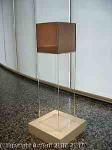Larry Bell
Larry Bell
Style: Light And Space;
Place: Chicago
Born: 1939
Biography:
Larry Bell is a contemporary American artist and sculptor. He lives and works in Taos, New Mexico, and maintains a studio in Venice, California. From 1957 to 1959 he studied at the Chouinard Art Institute in Los Angeles as a student of Robert Irwin, Richards Ruben, Robert Chuey, and Emerson Woelffer. He is a grant recipient from, among others, the National Endowment for the Arts and the Guggenheim Foundation, and his artworks are found in the collections of many major cultural institutions. Bell’s work has been shown at museums and in public spaces in the United States and abroad over the course of his 40-year career.
Bell's art addresses the relationship between the art object and its environment through the sculptural and reflective properties of his work. Bell is often associated with Light and Space, a group of mostly West Coast artists whose work is primarily concerned with perceptual experience stemming from the viewer's interaction with their work. This group also includes, among others, artists James Turrell, John McCracken, Peter Alexander, Robert Irwin and Craig Kauffman On the occasion of the Tate Gallery's exhibit Three Artists from Los Angeles: Larry Bell, Robert Irwin, Doug Wheeler, Michael Compton wrote the following to describe the effect of Bell's artwork:
At various times and particularly in the 1960s some artists have worked near what could be called the upper limits of perceptions, that is, where the eye is on the point of being overwhelmed by a superabundance of stimulation and is in danger of losing its power to control it... These artists sometimes produce the effect that the threat to our power to resolve what is seen heightens our awareness of the process of seeing...However, the three artists in this show... operate in various ways near the lowest thresholds of visual discrimination. The effect of this is again to cause one to make a considerable effort to discern and so to become conscious of the process of seeing.
"I came to (Venice Beach) in ’59 right out of art school because it was cheap", says the artist, born in Chicago in 1939. He followed friends like Billy Al Bengston, Robert Irwin, Ken Price, and Craig Kauffman to the beach. "He was the first and youngest person to crash the art scene of that era",[This quote needs a citation] says Edward Ruscha. The two met in the late 1950s at the Chouinard Art Institute (now part of CalArts), where Bell went from 1957-1959 with the intention of becoming a Disney animator. He found representation at the Ferus Gallery in Los Angeles, together with Edward Ruscha, Ed Moses, Billy Al Bengston.
Bell’s earliest pieces are paintings in the Abstract Expressionist tradition. He began incorporating fragments and shards of clear and mirrored glass into his compositions. At the same time, he began in his painting to produce angular geometric compositions that alluded to or represented three-dimensional forms. These works frequently depicted rectilinear forms with truncated corners. Next there came a series of shadow boxes or “ghost boxes”, three-dimensional cases whose surfaces often featured shapes reminiscent of those in the preceding paintings. Of this transition, critic Peter Frank has observed:
The earliest boxes contained within them, coated onto the glass or even defining their parameters, the angled contours and beveled edges with which the paintings had inferred three-dimensionality; the illusion of volume was thus conflated with actual volume.
From the shadow box pieces, Bell moved on to begin what is perhaps his most recognizable body of work, namely cube sculptures that rest on transparent pedestals. Bell first started constructing these pieces in the early ‘60s. The earliest examples frequently featured "the systematic use of modular internal divisions (ellipses, parallelograms, checker and hexagonal arrangements)", and used a variety of materials including formica, brass, and wood. Three of these works were included in the seminal 1966 exhibit, "Primary Structures" at the Jewish Museum in New York.
"Hewn from remaindered bits of glass salvaged at the Burbank frame shop where he worked while studying at Chouinard, Bell’s sculptures set the artist apart from his contemporaries. After the Sidney Janis Gallery sold one of his early cubes to Buffalo’s Albright-Knox Art Gallery, the Pace Gallery in New York offered him a solo show, along with representation, as did Ileana Sonnabend, then based in Paris," according to Michael Slenske.
Bell’s surfaces work both as mirrors and windows, sometimes simultaneously. In viewing the cubes, their suspension at torso height on clear pedestals designed by Bell allows the viewer to look up through them from underneath, as well as perceiving them from all four sides and from above. Bell’s sculptures have the effect of reading as self-contained objects while simultaneously drawing in their surroundings and proactively changing their environment. For these reasons, the sculptures’ effects depend heavily on their lighting and setting.
More...
Wikipedia link: Click Here





